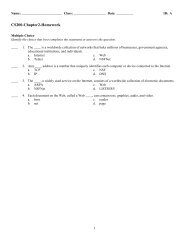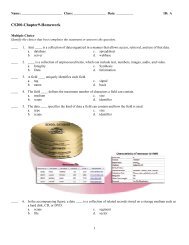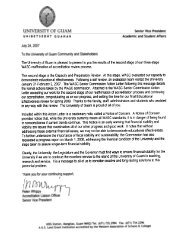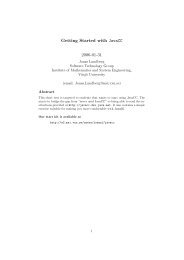Guam Business Resource Guide
Guam Business Resource Guide
Guam Business Resource Guide
You also want an ePaper? Increase the reach of your titles
YUMPU automatically turns print PDFs into web optimized ePapers that Google loves.
3.3.3.2 Competitive Analysis<br />
How many competitors, direct and indirect, are<br />
there in the marketplace and what are their competitive<br />
characteristics? Where does the business<br />
fit in; what market segment niche will be pursued?<br />
How will the business gain a competitive advantage<br />
over the competition? A competitive matrix is attached<br />
to summarize the competitive analysis.<br />
The relationship of supply and demand will affect<br />
the entire marketing plan in that high demand coupled<br />
with low supply usually indicates fewer competitors<br />
and lower marketing costs. Caution must<br />
be exercised to scan the current environment because<br />
new entrants will be drawn to the marketplace<br />
and their presence will change the market<br />
and affect the profit and cost dynamics of the<br />
product/service.<br />
Conversely, low demand and high supply indicates<br />
market saturation and the need for higher marketing<br />
costs. In this situation, market share must be<br />
gained by taking away customers from competitors<br />
and there will be a competitive reaction which<br />
must be addressed in the marketing plan.<br />
What is different about the business from other<br />
competing businesses? Successful businesses provide<br />
something that is unique. The various ways<br />
products/services are differentiated include:<br />
higher quality; better customer service; quality;<br />
responsiveness; safer/healthier; more attractive;<br />
more convenient; lower cost.<br />
3.3.3.3 Target Market/Customer Profile<br />
After completing the competitive and market<br />
analysis, the next step in the marketing plan is to<br />
target markets and customers who are most likely<br />
to benefit from and therefore purchase the company's<br />
products/services. The 80/20 rule is that<br />
80% of a company's revenues are generated by 20%<br />
of its customers. To make the business more profitable<br />
and competitive, it is important to try to<br />
reach market segments whose general characteristics<br />
indicate a highly probable usage and purchase<br />
of the company's products/services.<br />
Demographic information is usually available from<br />
county and city planning offices census data. This<br />
information includes the number of persons in age<br />
ranges, income levels, education levels, in households,<br />
residences, etc.<br />
3.3.3.5 Marketing Strategy/Market Share<br />
What are the specific plans and action steps to be<br />
taken to capture customers and market share during<br />
the planning period? How and who will sell the<br />
product/service? What is the advertising strategy?<br />
It is important that all promotional activities be<br />
consistent with the position and image of a business.<br />
What will the company do in terms of public<br />
relations?<br />
3.3.4 Operating and Control Systems<br />
This section of the business plan describes how the<br />
business will internally function in order to produce,<br />
deliver, monitor its products/services and<br />
the subsequent results. According to one wellrespected<br />
national business consulting firm, "one<br />
mark of the incompetent entrepreneur is a disdain<br />
for all the details involved in operating a business<br />
and controlling its activities." Without operating<br />
and control fully thought out and presented in the<br />
plan, a financier and/or investor will question<br />
whether e business can actually realize the goals<br />
set out in the business plan.<br />
3.3.4.1 Personnel<br />
How many employees will there be over the planning<br />
period? What types of functions will they perform?<br />
What are the skills required to fulfull job responsibilities?<br />
What will their hours be (part-time,<br />
shift, etc.)? What will be the pay scale and benefits<br />
offered by the company?<br />
3.3.4.2 Production/Service Methods<br />
How is the product/service actually produced? To<br />
illustrate the process, a day in the life of the company<br />
can be depicted from opening to closing. How<br />
is service performed? Do the clients come to an office<br />
or vice performed on the customer's site? What<br />
are the hours the business is open?<br />
3.3.3.4 Market Demographics/Size<br />
How large is the market (population, number of<br />
businesses)? What are the growth trends and potential<br />
for the market? Are there any market concentrations?<br />
10





![Residence Hall Application Form [PDF]](https://img.yumpu.com/46340085/1/190x245/residence-hall-application-form-pdf.jpg?quality=85)
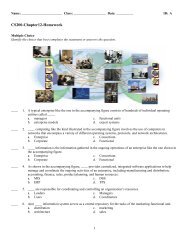

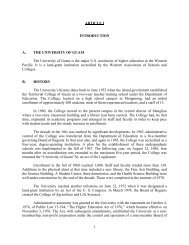
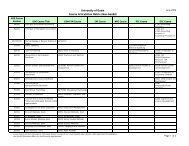
![Modern compiler design [PDF]](https://img.yumpu.com/37285279/1/190x245/modern-compiler-design-pdf.jpg?quality=85)
